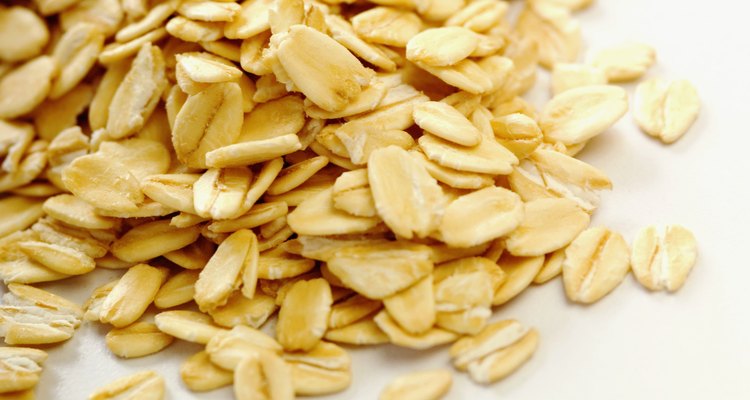
Often, oats are an underutilized grain in baking, but they are a great way to add flavor and nutrition to a variety of baked goods. Adding rolled oats alters the texture, flavor and nutritional value of baked items by creating a hearty, mildly nutty flavor while boosting fiber intake. Many recipes that call for oats will specify which type of oat to use. For those that do not, it helps to know the difference in types of oats.
Types
When oats are harvested, they look like a kernel of grain. This kernel is called a groat. Whole oat groats have had the inedible hull removed and take a long time to cook. Steel-cut oats are whole oat groats that have been cut into a few pieces with a steel blade. Rolled oats, often referred to as old-fashioned oats, are steamed, whole-oat groats that are rolled flat to look like oat flakes. This type of oat stays fresh longer, and holds its nutritional value and cooks much faster than steel-cut oats or whole-oat groats. Quick oats, or instant oats, take the process one step further. These oats are thinner and often appear to be oat-flake pieces, and are steamed longer. Oat flour is ground whole or rolled oats.
Rolled Oats
While some recipes can use rolled oats or quick oats interchangeably, rolled oats typically change the texture and look of baked goods. Because the rolled oats are thicker than quick-cooking oats, baked goods with rolled oats tend to be chewier in texture. Baked items with rolled oats, such as cookies, will show the oats more readily than if they were baked with quick oats. Since rolled oats need to cook longer, it is often preferable to bake with them as they produce a fluffier, heartier product. Quick oats cook quickly and tend to become mushy and may almost seem to disappear in the final product.
Differences
Baking with oats sometimes comes down to preference. Use the specific type of oat your recipe calls for. If it does not specify, determine whether you want to have a chewy, fluffier, more solid baked good, or a less chewy, more flour-like consistency to your final product. Rolled oats take longer to absorb moisture, therefore the oat holds up better in the final product. Quick oats absorb liquid faster and become more uniform in the baked item. The taste and nutritional value of rolled oats and quick-cooking oats are the same.
Substitutions
Rolled oats can be used in recipes that do not even call for oats, though they will change the texture and flavor of the baked product. Substitute rolled oats for flour, up to one-third the amount. Grind rolled oats in a blender or food processor to make your own oat flour. Oat flour can be substituted for all-purpose or whole-wheat flour one to one and will add a light, nutty flavor to your baked product.
Related Articles
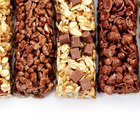
What Is the Difference Between Rolled ...

Can You Substitute Quick Cook Oats for ...
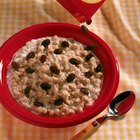
How to Make Quaker Oatmeal

Can I Substitute Bleached for ...

How Many Calories Do Oats Contain?
Cooking With Wheat Vs. White Flour

Can I Substitute Rolled Oats for Flour ...

Can You Substitute Whole Wheat Pastry ...
Is Unbleached Flour the Same as ...

Is Teff Flour Gluten-Free?
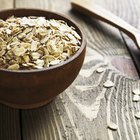
Proteins and Fiber in Oats

How to Substitute Cornstarch for ...
Can You Replace Bulgur With Barley?

How to Cook Oat Groats in a Crock Pot
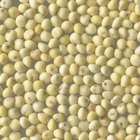
How to Cook Millet Meal

Can I Use All-Purpose Baking Mix to ...

Will Adding Cocoa Powder to a Cake Dry ...
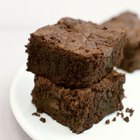
What Kind of Oil Do You Use in Brownie ...

Baking With Oats Instead of Flour

What Is White Oat?
References
Writer Bio
Nicole Adams is an accomplished writer, publishing in print and online. She has submitted hundreds of articles for websites, including CBS Local and Education.com. Adams earned a Bachelor of Science in psychology with concentrated studies in health and nutrition, and animal behavior and nutrition. She loves to cook and volunteers in animal rescue.
Photo Credits
Medioimages/Photodisc/Photodisc/Getty Images